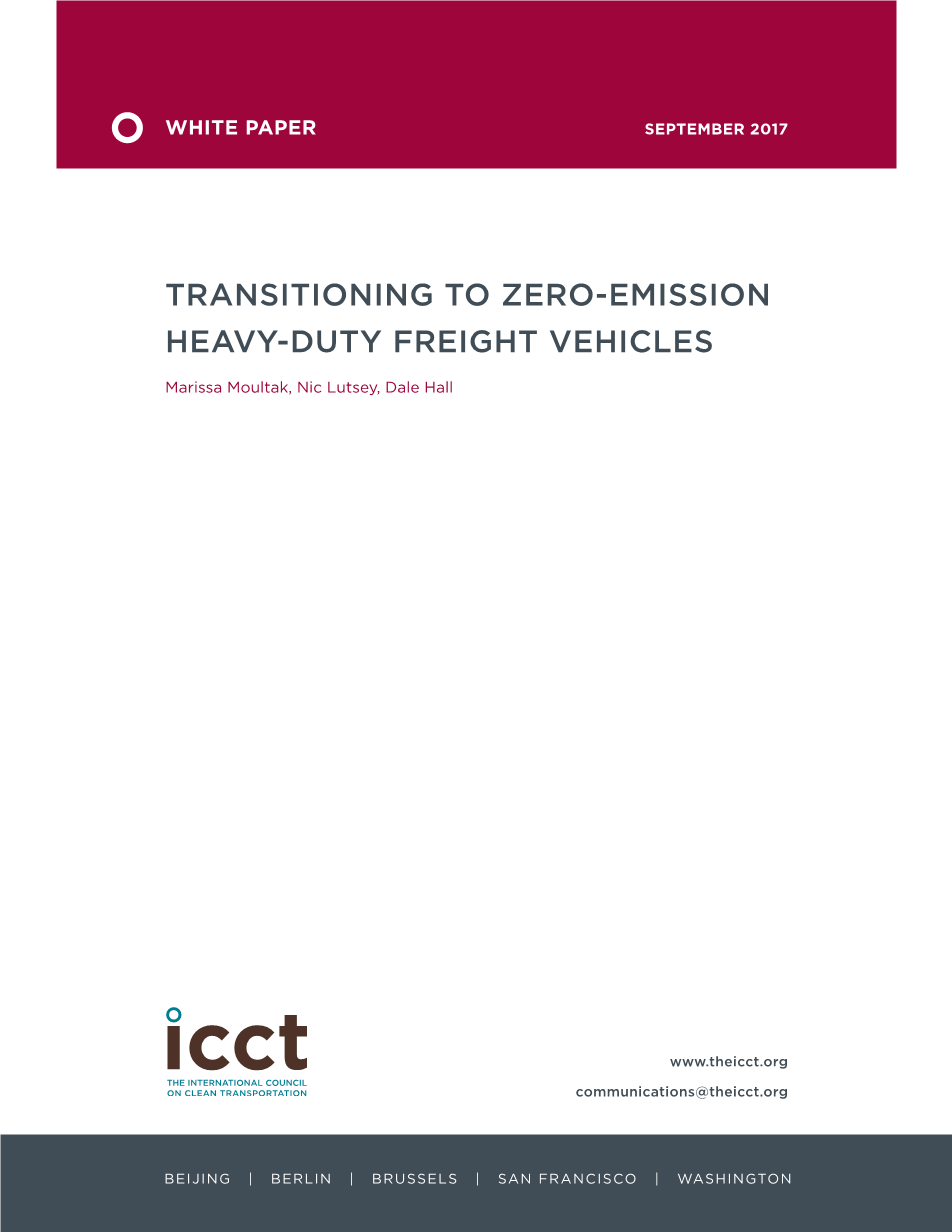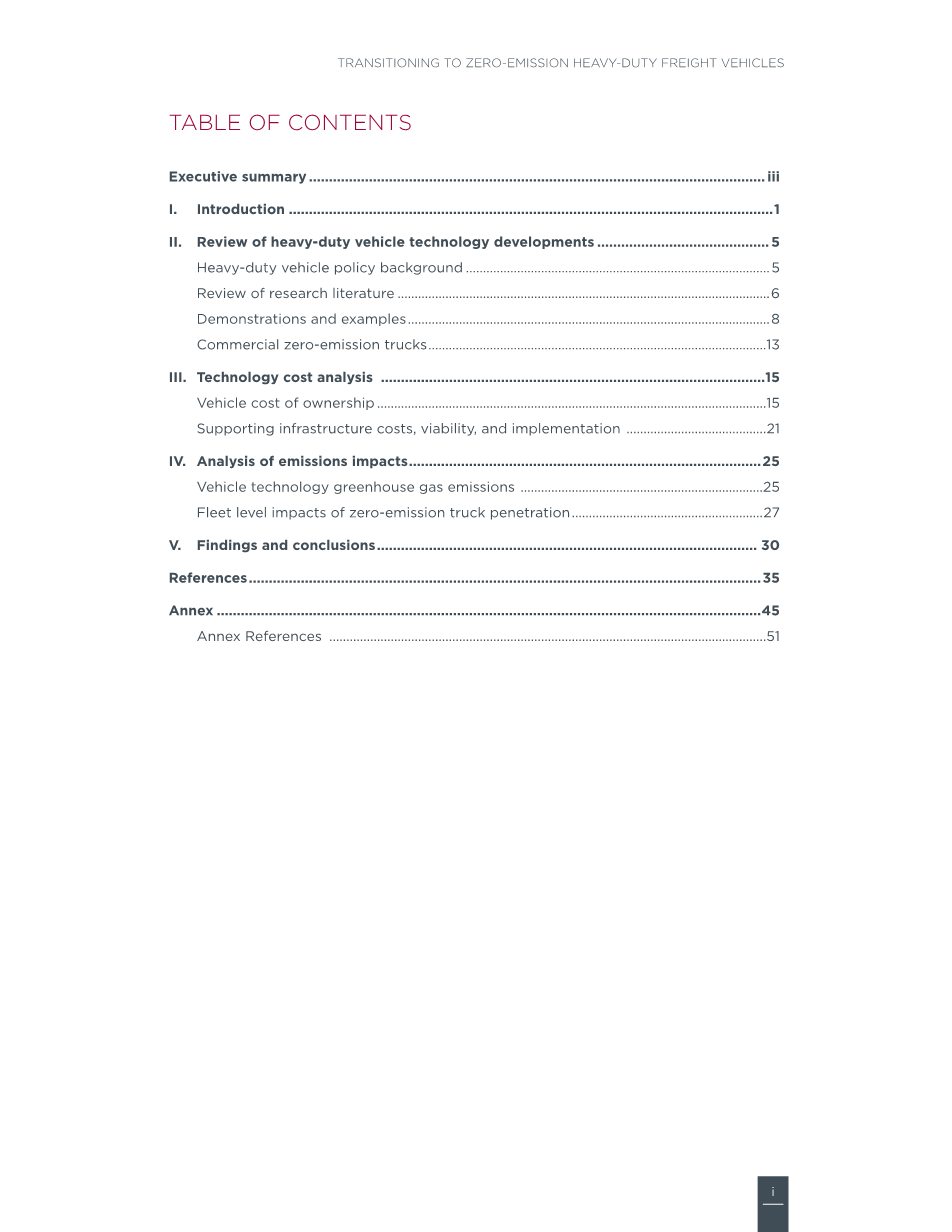

英语原文共 58 页,剩余内容已隐藏,支付完成后下载完整资料
BEIJING | BERLIN | BRUSSELS | SAN FRANCISCO | WASHINGTON
白皮书
2017年9月
向零排放重型货车过渡
Marissa Moultak, Nic Lutsey, Dale Hall
www.theicct.org communications@theicct.org
TABLE OF CONTENTS
Heavy-duty vehicle policy background 5
Review of research literature 6
Commercial zero-emission trucks 13
Supporting infrastructure costs, viability, and implementation 21
Vehicle technology greenhouse gas emissions 25
Fleet level impacts of zero-emission truck penetration 27
LIST OF FIGURES
Figure 1. Global vehicle stock, distance traveled, and life-cycle road transport greenhouse gas emissions by vehicle type in 2015. v
Figure 2. Projected global freight activity and life-cycle greenhouse gas
emissions from 2015 to 2050 vi
Figure 3. Ranges of zero-emission medium- and heavy-duty trucks currently
in development or production broken down by truck class. 12
Figure 4. Cost of ownership in China, Europe, and the United States for each long-haul heavy-duty truck technology for a vehicle purchased in
2015–2030 broken down by capital cost, maintenance cost, and fuel cost. 18
Figure 5. Additional cost for four different greenhouse gas reduction scenarios compared to the reference case (all fossil fuel use) for the long-haul heavy-duty freight transport sector in Germany (based on Kasten et al., 2016). 21
Figure 6. China, Europe, and U.S. lifecycle CO2 emissions over vehicle lifetime
(left axis) and per kilometer (right axis) by vehicle technology type 24
Figure 7. Lifecycle CO2e emissions from Europe heavy-duty tractor-trailer fleet from 2015–2050, with base case, efficiency improvements, fuel
cell-intensive, and electric-intensive scenarios. 26
LIST OF TABLES
Table 1. Quantitative studies of medium- and heavy-duty electric-drive vehicles. 4
Table 2. Medium-duty electric vehicle demonstration projects. 7
Table 3. Heavy-duty electric vehicle demonstration projects. 8
Table 4. In-road and catenary charging heavy-duty electric vehicle
Table 5. Medium- and heavy-duty hydrogen fuel cell vehicle demonstration projects. 10
Table 6. Estimated vehicle component costs for vehicles purchased in 2015–2030 15
Table 7. Total estimated tractor-trailer capital costs (in thousands of 2015 U.S. dollars) 16
Table 8. Fuel carbon intensities (gCO2e/MJ) for 2015 and 2030 and the
percent reduction in emissions from 2015 to 2030 23
Table 9. GHG emissions from EU tractor-trailers for baseline, fuel cell vehicle–intensive, and electric vehicle–intensive scenarios for 2050,
with associated change in emissions 27
Table 10. Summary of promising segments, benefits, and barriers for
zero-emission heavy-duty freight vehicle technologies 28
执行摘要
通往重型货运部门脱碳的明确道路一直是难以捉摸的。阻碍电动和氢燃料电池重型商用货车增长的障碍包括:技术可用性有限、规模经济有限、长途旅行要求、有效载荷质量和体积限制,以及缺乏加油和充电基础设施。许多政府和公司正寻求打破这些障碍,以帮助重型货车脱碳。
在本报告中,我们评估零排放重型车辆技术,以支持货运部门去碳化。我们比较了2025-2030年期间重型柴油、柴油混合动力、天然气、燃料电池和电池电力技术的发展。我们综合了研究文献、演示和低容量商用卡车的数据,以了解它们零排放运输货物的潜力。
我们通过中国、欧洲和美国三个汽车市场的拥有成本和生命周期温室气体排放量来分析新兴技术。
在此基础上,我们评估了各种新兴电力驱动技术的相对优缺点。表ES-1总结了我们关于零排放重型车辆技术优势和广泛采用障碍的调查结果。该表显示了三个主要的零排放技术领域的结果:插入式电动汽车、接触网或道路充电电动汽车以及氢燃料电池汽车。每项技术都有降低碳排放、无尾气排放和更多可再生能源使用的前景。将特定的电力和氢气技术与特定的卡车段相匹配,有助于克服诸如行驶里程、基础设施和充电时间等障碍。
表ES-1。总结零排放重型货车技术的有前景的部分、好处和障碍。
|
Technology |
Benefits |
Prevailing barriers to widespread viability |
Promising segments for widespread commercialization |
|
Electric (plug-in) |
|


